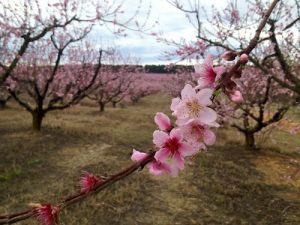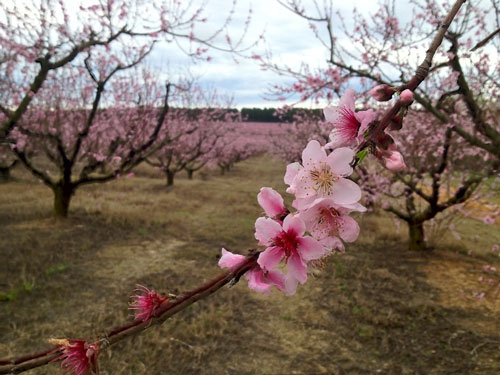 CLEMSON, S.C. – The warmer-than-normal temperatures of 2012 — the fourth warmest year on record in South Carolina — signal potential challenges for growers of the state’s best-known fruit. Peaches need cold weather to produce flowers and fruit. What happens when the chill is gone?
CLEMSON, S.C. – The warmer-than-normal temperatures of 2012 — the fourth warmest year on record in South Carolina — signal potential challenges for growers of the state’s best-known fruit. Peaches need cold weather to produce flowers and fruit. What happens when the chill is gone?
“In the spring, many of us think it’s longer days and warmer temperatures that start the growth cycle,” said Clemson University plant biologist Douglas Bielenberg. “Actually, peach leaf and flower buds are set the previous summer, then they go dormant in the winter. The tree must get sufficient chilling hours to trigger buds to open. Without this chill time, very few peach varieties will bloom well, if at all.”
With research funding from the Clemson University Experiment Station, Bielenberg’s work on plant dormancy and chilling can help plant breeders and the S.C. peach industry deal with agricultural and economic consequences of climate change.
The requirement for winter cold is the major factor in determining where peaches can be reliably grown for commercial fruit production. Historically, most commercially appealing peaches were developed in colder climates, where chilling hours posed no problem. In warmer regions, such as the coastal South, plant breeders had to cross those appealing peach varieties with lower-quality, low-chill varieties. Breeding premium fruit with low chilling hours has been an ongoing project.
“To grow peaches in low-chill areas breeders had to incorporate genes from trees that did not have elite fruit quality but did have low-chilling genes, which means they diluted the quality traits and then had to build them back up,” Bielenberg said. “This takes time — years and years. Our work provides research-based information and techniques to breeders to speed up the incorporation of low-chill genes into current elite cultivars while maintaining high fruit-quality traits. The goal is to adapt our current cultivars to future warmer winters.”
But there is a flip side to the temperature dilemma. Peaches also need warm temperatures at the right time. An early spring warmup followed by a plummeting cold snap can bring disaster.
This is what happened in 2007 when the entire state crop was wiped out, said Bielenberg. Before the buds open they are more frost resistant. The ideal system would be a chilling requirement that matches local winter conditions combined with a higher heat requirement to keep buds closed longer and protect them from possible sharp freezes.
“The work we are doing not only involves understanding the chilling requirement, but also should help us breed for increased heat requirement to help protect the industry from late freezes,” he said. The challenge is that heat requirement is not very well understood and is difficult to study since the timing of chilling and heat requirements overlap.
The temperature needs to be around 45 degrees or lower to meet the chill requirement for peaches. Different varieties need varied chilling times ranging from a couple of hundred hours to more than a thousand. Peach trees can “count” the chilling hours and suspend the count if there is a warm spell, then continue where they stopped when the chilling hours begin again.
Much remains unknown, Bielenberg said. How does a peach tree “sense” the temperature? How does it keep track of the number of chilling hours? How does it blend chilling hours with warming temperatures to control blossoming and growth?
“You can think of what we don’t know as a ‘black box,’ and we haven’t figured out how to see what’s going on inside,” he said.
Bielenberg and colleagues Gregory Reighard and Ksenija Gasic in Clemson’s School of Agriculture, Forestry and Life Sciences are analyzing the peach genome looking for “DNA road signs” — markers — that can locate genes involved in chilling requirements, dormancy and growth.
“What we are learning is that there is not just one gene that controls the process; and it’s not just about sufficient cooler temperatures but also warm temperatures, too,” Bielenberg said.
The work will go a long way toward giving breeders like Gasic the tools to adapt fruit trees to climate change.
Second to top-producer California, South Carolina peach growers harvest about 90,000 tons per year valued at $60 million. Each year Clemson plant scientists evaluate more than 350 peach varieties to provide information needed by South Carolina growers.
Bielenberg and his colleagues have planted a special stand of 400 peach trees that contain genetic material between the extremes of chilling requirements. The seeds were given to Bielenberg by their developer, USDA Agriculture Research Service plant breeder W.R. Okie. They provide an opportunity to discover the mechanisms that cause variations in chilling requirements and may lead to discovering how to keep producing South Carolina peaches in spite of warming temperatures.
Understanding how the process works could affect other perennial fruit and nut crops, such as apples and pears, which are not related but require chilling hours.

